|
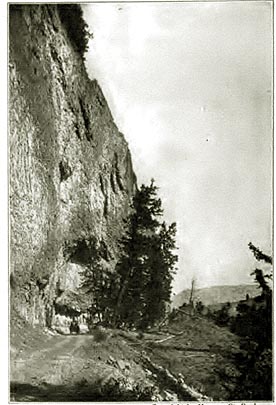 . . . . 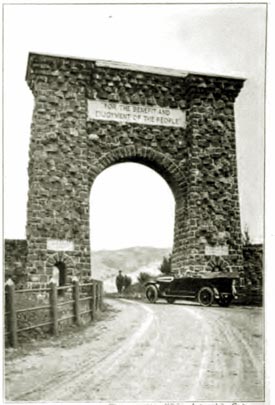
Left, Tower Falls Road, 1916. Right, First Motor Car passing through Roosevelt Arch, Aug. 1, 1915.
As indicated in the upper left photo, prior to 1916, roads in the Park were really not suitable for motor travel.
Prior to 1916, motor cars were not permitted in the park. Transportation within the park was by 4 and 6-horse coaches, two-horse surreys, or by saddle and pack outfits.
Guides proclaimed the joys of sitting on the roof of the coach which carried tourists from the train station at Gardiner.
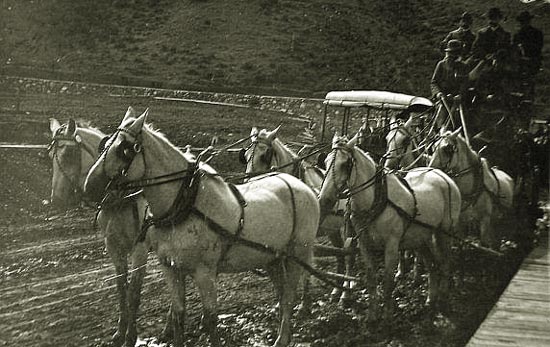
Stage departing railroad station at Gardiner.
Motor cars bringing tourists from Cody were only permitted as far as
the East Gate. From there, tourists transferred to stages. Tourists entering the Park from the train station at Gardiner were transferred to
their hotel or camping ground by stage. Nevertheless, on August 1, 1915, the first motor cars entered the
Park from Gardiner and proceeded past the Upper Geyser Basin to Old Faithful Lodge. The winds of change began to blow during the administration of
President Theodore Roosevelt. Roosevelt recommended civilian
control over Yellowstone. Congress moves slowly its wonders to enact. In 1912, Roosevelt's successor, President Taft, again recommended that Congress appropriate funds to turn the
park over to civilian control. Four years later Congress finally acted.
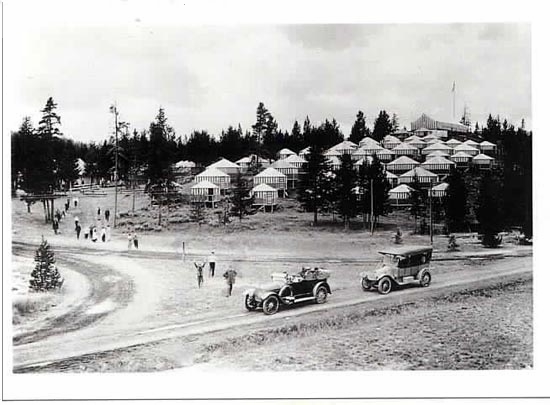
First Motor Cars in Yellowstone passing Upper Basin Camp of the
Wylie Permanent Camping Company, August 1, 1915.
In 1916, the Act creating the National Park Service was adopted.
In October of that year, the National Park Service assumed administration.
The same year, the Secretary of the Interior, Franklin K. Lane, in his report noted that
all of the National Parks were open to motor travel and observed that with the
construction of roads the parks would become more available to the people.
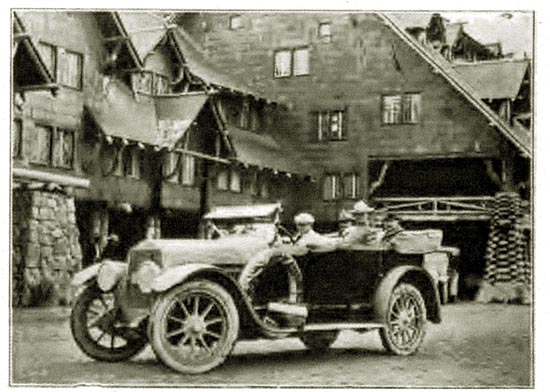
First Motor Car arriving at Old Faithful Lodge, August 1, 1915. Note the mud on the tires, wheels, and
fenders.
Not withstanding the improvement of the roads, they were not necessarily for the faint of heart.
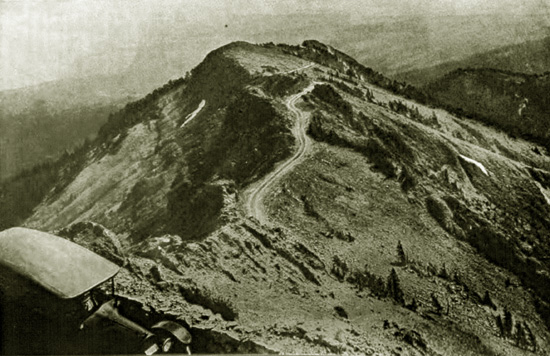
Motor road to top of Mount Washburn, 1918. Photo by C. J. Belden.
Note the absence of guard rails where the road crosses the saddle.
The operation of motor cars was strictly regulated. The machines were not permitted to exceed 12 miles per hour
ascending hills and 10 miles per hour descending. On straight-aways with no teams of horses within
200 yards, the machines were permitted to be operated up to 20 miles per hour. On curves the speed limit was 8 miles per hour.
Motorists were warned that due to the elevation of the park, power of the machines was sharply reduced and about 50 per cent more
gasoline was likely to be used and that caution should be exercised in not over-heating one's engine.
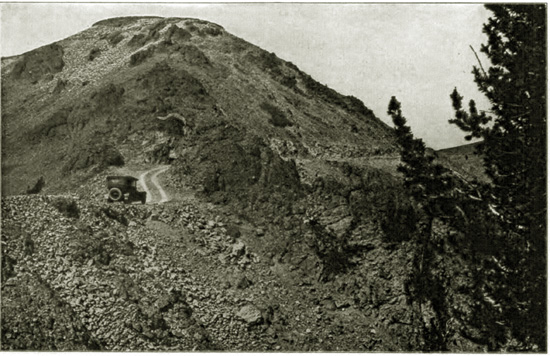
Motor road to top of Mount Washburn, 1918. Photo by C. J. Belden.
Belden in his "The Motor in Yellowstone," Scribner's Magazine, 1918, reassures us that there is no problem
from the grade:
Descending toward Tower Falls an excellent idea of the grade is gained from the
fact that in the two miles to the junction with the route over Dunrave Pass the aneroid indicates a drop of
fifteen hundred and fifty feet. The corners are not excessively sharp, however, and
by engaging low or intermediate gear, and opening the priming cups on the engine, the braking effect is such
that the hand or foot brakes need hardly be touched.
For discussion and other Belden photos, see Belden.
Priming cups were used on cars prior to 1922. They were brass cups afixed to the intake manifold for
each cylinder which permitted one to directly inject gasoline or ether into the cylinder to assist
in starting one's machine when cold without the necessity of unscrewing the sparkplugs. Opening the cups would keep gasoline from entering the
cylinder and would, thus, increase the engine's braking.
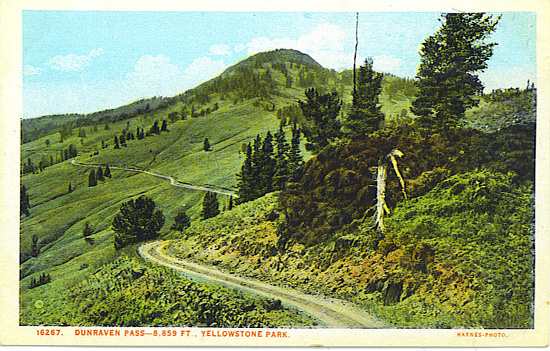
Dunraven Pass, approx. 1918. Haynes Photo.
Prior to 1916, Park Hotels, campgrounds, and transportation
were operated by a number of concessionaires. Hotels were operated by the Yellowstone
Park Association with other hotels owned by Frank Jay Haynes. Tent campgrounds, similar to that depicted above, were
operated by the Wylie Permanent Camping Company and by Shaw and Powell Camping Company. Each
provided transportation and tours by stages for their customers. Transportation was
also provided by the Cody-Sylvan Pass Stagecoach Company of Pahaska, the
Yellowstone and Monida Company from West Yellowstone and the Yellowstone Transportation
Company of Gardiner.
The resumption of civiliam control of the
Park resulted in drastic changes. Stages were replaced by "auto stages," operation of
the hotels and campgrounds were consolidated.
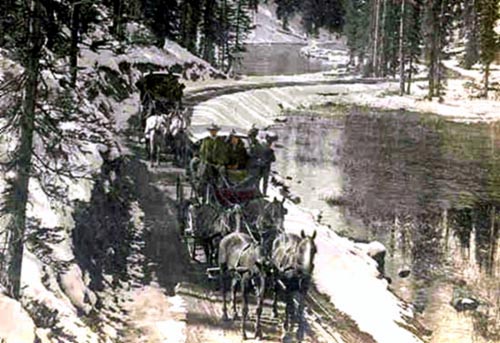
Stages along Two-Ocean Creek
The Creek divides one portion floring ultimately into the Snake and the Pacific and the other portion foowing into
the Yellowstone and the Atlantic.
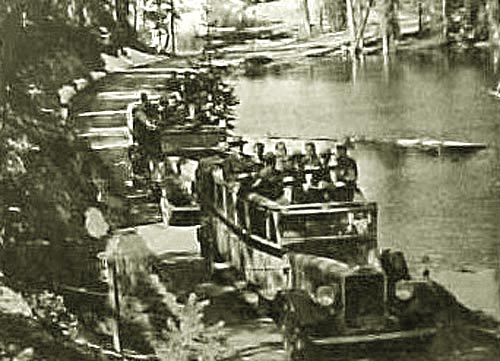
Motor buses along Two-Ocean Creek.
Next Page: Yelllowstone continued.
|













